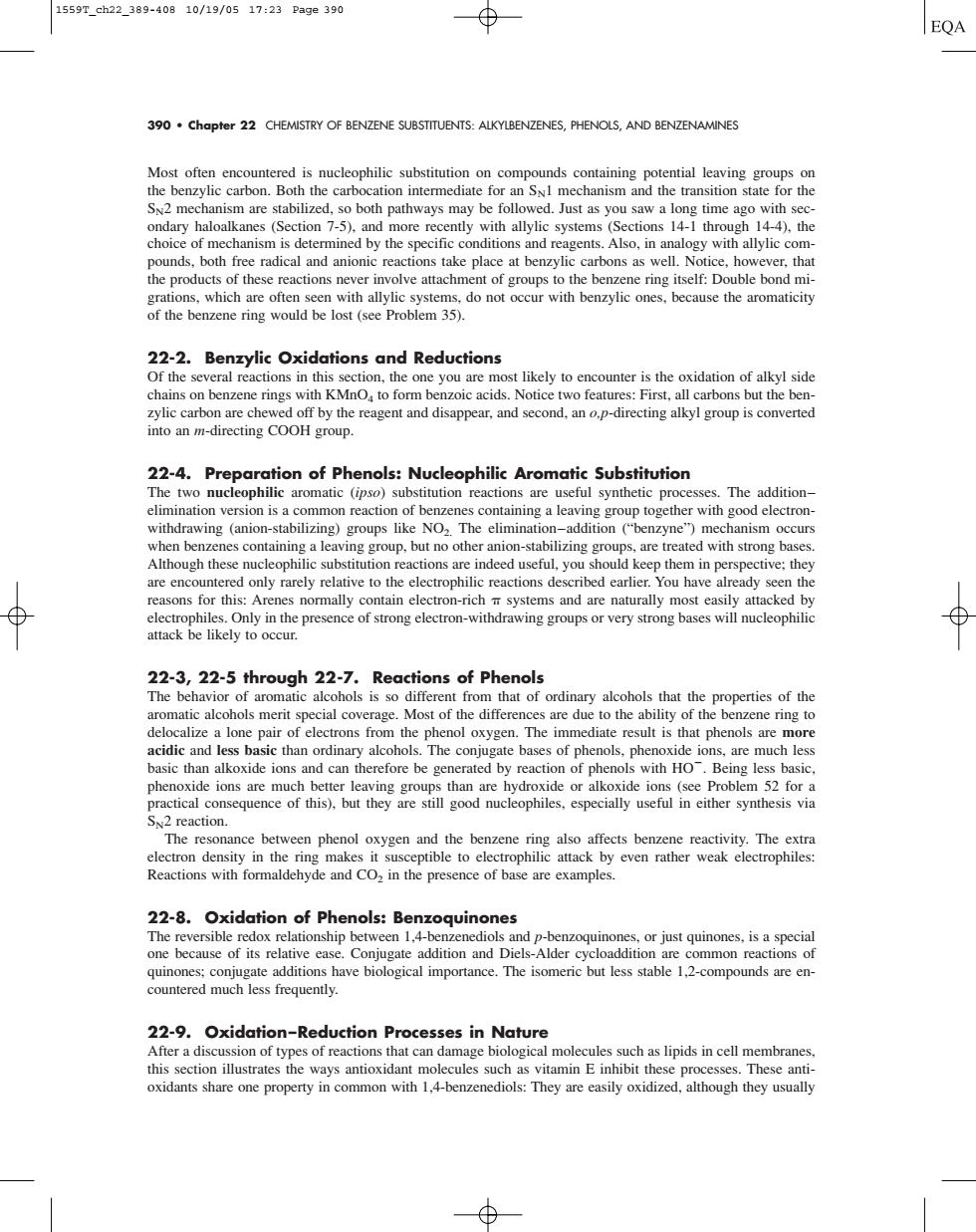正在加载图片...

1559Tch22389-40810/19/0517:23Page390 ⊕ EQA 390 chapter 22 CHEMISTRY OF BENZENE SUBSTITUENTS:ALKYLBENZENES,PHENOLS,AND BENZENAMINES Most ofte encounte d is nucleophilic substitution on comp potential Ss2 mechanism are stabilized.so both pathways may be followed.Just as you saw a long time ago with sec ondary (Sectio) 4.h pounds.both free radical and anionie reactions take place at benzyli carbons as well.Notice.however.tha the products of these reactions ne er involve attachment of groups to the benzene ring itself:Double bond mi 22.2.Ben Of the several reactions in this section.the one you are most likely to encounter is the oxidation of alkyl side chains on benzene rings with KMnO to form benzoic acids.Notice two features:First,all carbons but the ben emmnCgC0oHpcreaecnnddapea.andocoad.anop-tirctimgaglgroupiscoanento 22-4.Pr ration of Phenols:Nucleophilic Aro The two nuceophilic aromatic (is)substitution reactions are useful synthetic processes.The addition- elimination version is a common reaction of be zees containing a leaving group together with good electron- withdr wing (ani 2 on ber Although these reactions are indeed useful you should keep them in perspective:the are encountered only rarely relative to the electrophil c reactions de cribed earlier You have a lready sen attack be likely to occur. 22-3,22-5 through 22-7.Reactions of Phenols The that of ordi ary alcohols that th zen.The immediate result is that phenols are more acidic and le ess ba asic than ordinary alcohols.The conjugate bases of phenols,phenox are much less much hd car 52 for ica coequence of thi),but they stll good nucleophiles,especially usefu in either synthesis via ce between phenol oxygen and the benzene ring also affects benzen activity.The extr electron density in the ing makes eptible to electrophilic attack by even rather weak electrophiles Reactions with formaldehyde and CO in the presence of base are examples. 22-8.Oxidation of Phenols:Benzoquinones The evers 22-9.Oxidation-Reduction Processes in Nature ucas lipids in cellm embrane neagmMost often encountered is nucleophilic substitution on compounds containing potential leaving groups on the benzylic carbon. Both the carbocation intermediate for an SN1 mechanism and the transition state for the SN2 mechanism are stabilized, so both pathways may be followed. Just as you saw a long time ago with secondary haloalkanes (Section 7-5), and more recently with allylic systems (Sections 14-1 through 14-4), the choice of mechanism is determined by the specific conditions and reagents. Also, in analogy with allylic compounds, both free radical and anionic reactions take place at benzylic carbons as well. Notice, however, that the products of these reactions never involve attachment of groups to the benzene ring itself: Double bond migrations, which are often seen with allylic systems, do not occur with benzylic ones, because the aromaticity of the benzene ring would be lost (see Problem 35). 22-2. Benzylic Oxidations and Reductions Of the several reactions in this section, the one you are most likely to encounter is the oxidation of alkyl side chains on benzene rings with KMnO4 to form benzoic acids. Notice two features: First, all carbons but the benzylic carbon are chewed off by the reagent and disappear, and second, an o,p-directing alkyl group is converted into an m-directing COOH group. 22-4. Preparation of Phenols: Nucleophilic Aromatic Substitution The two nucleophilic aromatic (ipso) substitution reactions are useful synthetic processes. The addition– elimination version is a common reaction of benzenes containing a leaving group together with good electronwithdrawing (anion-stabilizing) groups like NO2. The elimination–addition (“benzyne”) mechanism occurs when benzenes containing a leaving group, but no other anion-stabilizing groups, are treated with strong bases. Although these nucleophilic substitution reactions are indeed useful, you should keep them in perspective; they are encountered only rarely relative to the electrophilic reactions described earlier. You have already seen the reasons for this: Arenes normally contain electron-rich systems and are naturally most easily attacked by electrophiles. Only in the presence of strong electron-withdrawing groups or very strong bases will nucleophilic attack be likely to occur. 22-3, 22-5 through 22-7. Reactions of Phenols The behavior of aromatic alcohols is so different from that of ordinary alcohols that the properties of the aromatic alcohols merit special coverage. Most of the differences are due to the ability of the benzene ring to delocalize a lone pair of electrons from the phenol oxygen. The immediate result is that phenols are more acidic and less basic than ordinary alcohols. The conjugate bases of phenols, phenoxide ions, are much less basic than alkoxide ions and can therefore be generated by reaction of phenols with HO. Being less basic, phenoxide ions are much better leaving groups than are hydroxide or alkoxide ions (see Problem 52 for a practical consequence of this), but they are still good nucleophiles, especially useful in either synthesis via SN2 reaction. The resonance between phenol oxygen and the benzene ring also affects benzene reactivity. The extra electron density in the ring makes it susceptible to electrophilic attack by even rather weak electrophiles: Reactions with formaldehyde and CO2 in the presence of base are examples. 22-8. Oxidation of Phenols: Benzoquinones The reversible redox relationship between 1,4-benzenediols and p-benzoquinones, or just quinones, is a special one because of its relative ease. Conjugate addition and Diels-Alder cycloaddition are common reactions of quinones; conjugate additions have biological importance. The isomeric but less stable 1,2-compounds are encountered much less frequently. 22-9. Oxidation–Reduction Processes in Nature After a discussion of types of reactions that can damage biological molecules such as lipids in cell membranes, this section illustrates the ways antioxidant molecules such as vitamin E inhibit these processes. These antioxidants share one property in common with 1,4-benzenediols: They are easily oxidized, although they usually 390 • Chapter 22 CHEMISTRY OF BENZENE SUBSTITUENTS: ALKYLBENZENES, PHENOLS, AND BENZENAMINES 1559T_ch22_389-408 10/19/05 17:23 Page 390�